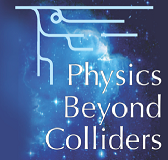The high intensity secondary beams at the SPS M2 beam line in combination with the world’s largest polarized nucleon targets as well as large liquid hydrogen and a broad variety of nuclear targets put the COMPASS collaboration in a unique position as a universal experimental facility to study previously unexplored aspects of meson and nucleon structure, QCD dynamics and hadron...
NA61/SHINE is a multi-purpose experimental facility to study hadron production in hadron-proton, hadron-nucleus and nucleus-nucleus collisions for physics of strong interactions, neutrinos and cosmic-rays. NA61/SHINE approved data taking programme should be completed by the end of 2018. This presentation summarizes requests for new measurements and necessary facility upgrades. The former...
Searches for dark-matter (DM) candidates in the MeV to few-GeV mass range feebly interacting with SM particles are generating much interest: as suggested by different authors, thermal relics due to these long-lived particles might account for the observed DM abundance in the universe. Provided NA62 reaches its limiting sensitivity for the precise measurement of the ultra-rare FCNC K+ —> pi+ nu...
Experiments at the Antiproton Decelerator of CERN compare the fundamental properties of matter/antimatter conjugates at lowest energies and with great precision. Such efforts provide stringent tests of the fundamental charge-parity-time invariance of the Standard Model, and allow testing of the equivalence principle of general relativity. Using single particles in Penning traps the most...
The search for physics beyond the Standard Model can be performed complementary to high-energy physics by conducting studies at lowest energies. The achieved extraordinary precision is needed for reaching similar or even improved sensitivity limits. Radionuclides provide in this respect an ideal laboratory for addressing properties of all known fundamental interactions. High-precision nuclear...
